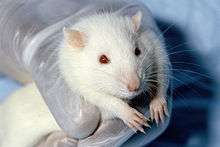Laboratory animal allergy
Laboratory animal allergy (LAA) is an occupational disease of laboratory animal technicians and scientists.[1][2] It manifests as an allergic response to animal urine, specifically the major urinary proteins (Mups) of rodents, and can lead to the development of asthma.[3] A study of 5641 workers in Japan who were exposed to laboratory animals found 23.1% had one or more allergic symptoms; globally the prevalence among at risk workers is estimated between 11 and 30% [4] According to the National Institutes of Health, prevention of animal allergy depends on the control of allergens in the work environment. This involves a combination of measures to eliminate or control allergen exposure, including engineering controls, administrative controls, and personal protective equipment.[5]
The protein product of the mouse Mup17 gene,[6] known as Mus m 1, Ag1 or MA1,[7] accounts for much of the allergenic properties of mouse urine. Similarly, the product of the rat Mup13 gene, Rat n 1, is also a potent human allergen.[3] One study found that two thirds of laboratory workers who had developed asthmatic reactions to animals had antibodies to Rat n 1.[8]
Notes
- Gordon S, Preece R (September 2003). "Prevention of laboratory animal allergy". Occupational Medicine. 53 (6): 371–7. doi:10.1093/occmed/kqg117. PMID 14514903.
- Wood RA (2001). "Laboratory animal allergens". ILAR Journal. 42 (1): 12–6. doi:10.1093/ilar.42.1.12. PMID 11123185.
- Lockey, Richard; Ledford, Dennis K. (2008). "Mammalian Allergens". Allergens and Allergen Immunotherapy. Volume 21 of Clinical allergy and immunology. Informa Health Care. pp. 201–218. ISBN 978-1-4200-6197-0.
- Aoyama K, Ueda A, Manda F, Matsushita T, Ueda T, Yamauchi C (January 1992). "Allergy to laboratory animals: an epidemiological study". British Journal of Industrial Medicine. 49 (1): 41–7. doi:10.1136/oem.49.1.41. PMC 1039233. PMID 1733454.
- The National Institutes of Health Laboratory Animal Allergy Prevention Program
- Garg LC, Narang N (1989). "Suppression of ouabain-insensitive K-ATPase activity in rabbit nephron segments during chronic hyperkalemia". Renal Physiology and Biochemistry. 12 (5–6): 295–301. doi:10.1159/000173206. PMID 2533699.
- Lorusso JR, Moffat S, Ohman JL (November 1986). "Immunologic and biochemical properties of the major mouse urinary allergen (Mus m 1)". The Journal of Allergy and Clinical Immunology. 78 (5 Pt 1): 928–37. doi:10.1016/0091-6749(86)90242-3. PMID 3097107.
- Platts-Mills TA, Longbottom J, Edwards J, Cockroft A, Wilkins S (March 1987). "Occupational asthma and rhinitis related to laboratory rats: serum IgG and IgE antibodies to the rat urinary allergen". The Journal of Allergy and Clinical Immunology. 79 (3): 505–15. doi:10.1016/0091-6749(87)90369-1. PMID 3819230.
